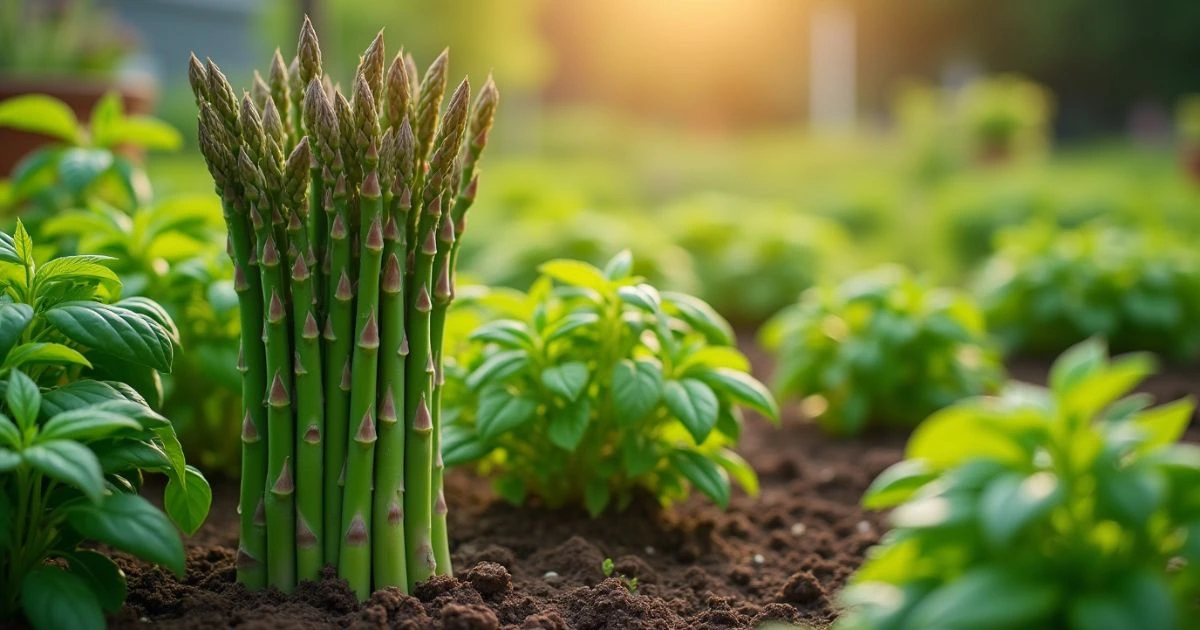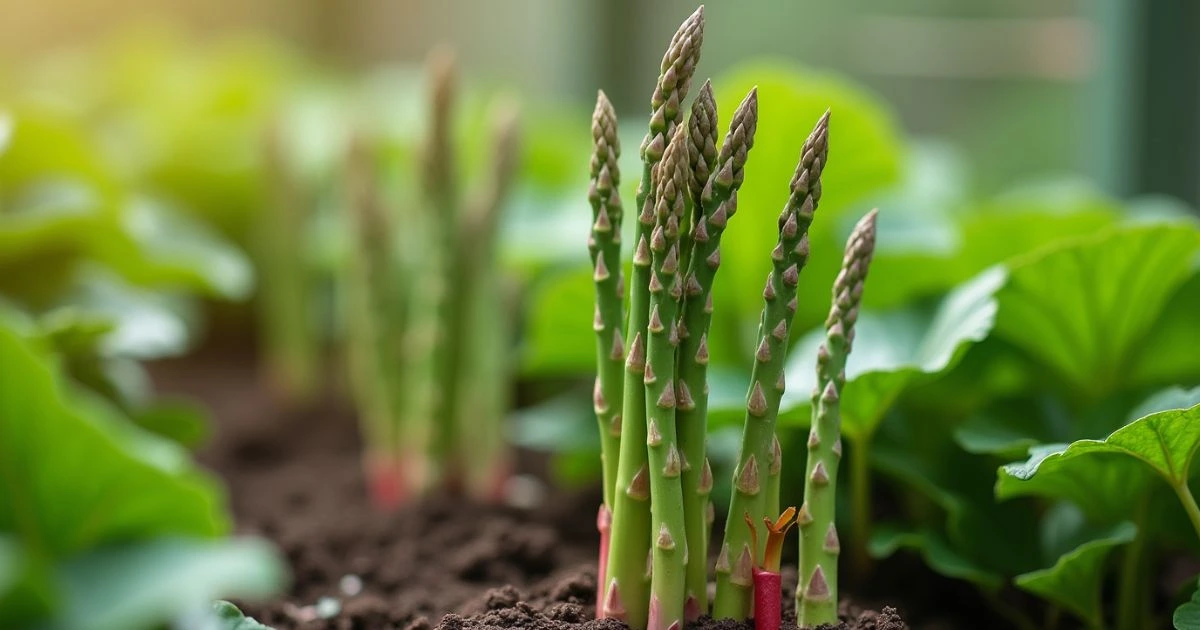Asparagus companion plants hold the key to creating a harmonious and thriving garden. Whether you’re a beginner or an experienced gardener, pairing the right plants with asparagus can lead to healthier growth, fewer pests, and a bountiful harvest. But not all plants are beneficial—some can hinder your asparagus’ success.
In this guide, we’ll explore the best and worst companion plants for asparagus, backed by proven gardening techniques. Let’s dive into the allies and enemies that influence your asparagus bed’s productivity.
Table of Contents
What Are Asparagus Companion Plants?
Companion planting is an eco-friendly gardening technique that involves pairing plants to offer mutual benefits. When companion planting asparagus, these combinations enhance soil quality, repel pests, and promote higher yields.
For instance, planting basil near asparagus helps repel harmful insects, while parsley retains soil moisture. Conversely, crops like potatoes can disturb asparagus roots and should be avoided. Grasping these dynamics will pave the way for gardening success.
12 Best Companion Plants for Asparagus
Here’s a breakdown of the best companion plants for asparagus, designed to protect and enhance your garden.
1. Tomatoes – A Natural Protector

Tomatoes and asparagus are a perfect pairing in the garden. Tomatoes produce solanine, a natural pesticide that repels asparagus beetles. In exchange, asparagus helps repel nematodes that can damage tomato plants.
- Why It Works: Their mutual pest-repelling properties benefit both crops.
- Placement Tip: Plant tomatoes around the edges of your asparagus bed.
2. Basil – A Fragrant Ally

Basil adds a pleasant aroma to the garden while repelling pests such as aphids and whiteflies. This herb also draws beneficial pollinators, making it a great addition to your asparagus bed.
- Why It Works: Basil’s pest-control properties protect asparagus.
- How to Use: Interplant basil among asparagus rows for best results.
3. Parsley – Soil Protector

Parsley acts as a ground cover, reducing soil erosion and keeping pests at bay. This herb doesn’t compete with asparagus for resources, making it an ideal partner.
- Why It Works: Parsley supports soil health and moisture retention.
- Pro Tip: Allow parsley to grow around the base of your asparagus.
4. Spinach – A Quick Companion

Spinach grows quickly and doesn’t interfere with asparagus roots. It serves as a temporary companion, protecting soil before asparagus shoots appear.
- Why It Works: Spinach prevents weed growth and enriches soil.
- Timing Tip: Plant spinach early in the season for maximum benefits.
5. Marigolds – A Garden Guard

Known for their vibrant flowers, marigolds repel nematodes and other harmful insects. They also attract pollinators that benefit your entire garden.
- Why It Works: Marigolds release chemicals that deter soil pests.
- How to Plant: Use marigolds as a border around your asparagus bed.
6. Dill – Attracts Beneficial Insects

Dill invites pollinators and predatory insects like ladybugs and parasitic wasps. These natural allies keep asparagus pests under control.
- Why It Works: Dill encourages a balanced ecosystem.
- Garden Tip: Regularly trim dill to prevent overgrowth.
7. Rhubarb – A Complementary Partner

Can you plant rhubarb and asparagus together? Yes! Rhubarb and asparagus coexist well, as their deep root systems occupy different soil layers.
- Why It Works: Rhubarb doesn’t compete for nutrients.
- Spacing Advice: Leave at least 2 feet between rhubarb and asparagus plants.
Plants to Avoid Near Asparagus
Certain plants can harm your asparagus by competing for nutrients or attracting pests. Avoid these bad companions:
8. Garlic and Onions
Though these alliums deter some pests, they compete with asparagus for nutrients, leading to stunted growth.
- Why to Avoid: Alliums deplete the soil of essential resources.
- Alternative: Grow garlic and onions in separate garden beds.
9. Potatoes
Potatoes are nutrient-hungry crops that disturb the soil when harvested, potentially damaging asparagus roots.
- Why to Avoid: They disrupt the soil and compete for nutrients.
- Solution: Keep potatoes far from your asparagus patch.
10. Mint
Mint is highly invasive, spreading rapidly and choking out slower-growing crops like asparagus.
- Why to Avoid: Its aggressive growth habit overpowers asparagus.
- Containment Tip: Grow mint in containers to prevent spreading.
11. Fennel
Fennel emits compounds that hinder the growth of surrounding plants, including asparagus.
- Why to Avoid: It disrupts the growth of neighboring crops.
- Alternative: Opt for dill or parsley instead.
Why Companion Planting Works for Asparagus
Companion planting leverages the natural interactions between plants to create a healthier, more productive garden.
- Pest Control: Many companion plants repel pests that target asparagus.
- Soil Health: Plants like parsley and spinach enrich the soil and prevent erosion.
- Space Optimization: Combining crops with different growth habits maximizes garden space.
A Practical Companion Planting Plan
Here’s a sample layout for a thriving asparagus bed:
| Plant | Position | Benefit |
| Tomatoes | Around bed edges | Deters beetles |
| Basil | Between asparagus rows | Attracts pollinators |
| Marigolds | Border of bed | Controls nematodes |
| Parsley | Around asparagus plants | Retains soil moisture |
Frequently Asked Questions (FAQs)
Q: What are the ideal companion plants for asparagus?
A: Tomatoes, basil, marigolds, dill, and parsley are top choices.
Q: Can you plant rhubarb and asparagus together?
A: Yes, they complement each other well with proper spacing.
Q: What plants should I avoid planting near asparagus?
A: Avoid garlic, onions, potatoes, mint, and fennel.
Pairing the right companion plants for asparagus is more than just a clever gardening technique—it’s a transformative approach to building a healthier, more productive garden. By understanding the symbiotic relationships between plants, you can create an environment where your asparagus thrives naturally, with fewer interventions needed.
Good companions, like tomatoes, basil, and marigolds, not only deter pests but also improve soil health and encourage pollination. On the other hand, avoiding poor companions, such as potatoes and fennel, ensures that your asparagus remains free from competition and disruption. Each plant you choose to grow alongside asparagus has the potential to influence its growth, health, and yield, making informed decisions critical for success.
Companion planting isn’t just about benefits—it’s about balance. It fosters a mini ecosystem in your garden, where each plant plays a role in supporting others. Whether you’re a seasoned gardener or just starting, this strategy empowers you to work with nature instead of against it.
Now is the perfect time to take your gardening skills to the next level. Review your garden layout, research more about the plants you wish to include, and experiment with different combinations. Don’t be afraid to make adjustments as you learn what works best in your unique environment.
Ready to transform your asparagus bed into a thriving hub of activity? Start implementing these companion planting strategies today. Share your results, challenges, and tips with our community in the comments. Together, we can grow greener, healthier gardens!


